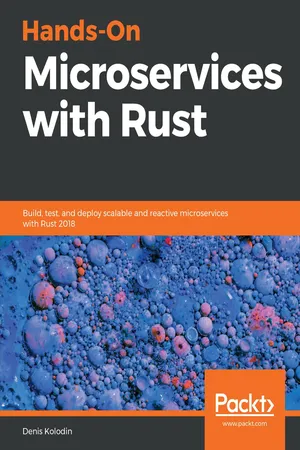
Hands-On Microservices with Rust
Build, test, and deploy scalable and reactive microservices with Rust 2018
- 520 pages
- English
- ePUB (mobile friendly)
- Available on iOS & Android
Hands-On Microservices with Rust
Build, test, and deploy scalable and reactive microservices with Rust 2018
About this book
A comprehensive guide in developing and deploying high performance microservices with Rust
Key Features
- Start your microservices journey and get a broader perspective on microservices development using RUST 2018,
- Build, deploy, and test microservices using AWS
- Explore advanced techniques for developing microservices such as actor model, Requests Routing, and threads
Book Description
Microservice architecture is sweeping the world as the de facto pattern for building web-based applications. Rust is a language particularly well-suited for building microservices. It is a new system programming language that offers a practical and safe alternative to C.
This book describes web development using the Rust programming language and will get you up and running with modern web frameworks and crates with examples of RESTful microservices creation. You will deep dive into Reactive programming, and asynchronous programming, and split your web application into a set of concurrent actors. The book provides several HTTP-handling examples with manageable memory allocations. You will walk through stateless high-performance microservices, which are ideally suitable for computation or caching tasks, and look at stateful microservices, which are filled with persistent data and database interactions. As we move along, you will learn how to use Rust macros to describe business or protocol entities of our application and compile them into native structs, which will be performed at full speed with the help of the server's CPU.
Finally, you will be taken through examples of how to test and debug microservices and pack them into a tiny monolithic binary or put them into a container and deploy them to modern cloud platforms such as AWS.
What you will learn
- Get acquainted with leveraging Rust web programming
- Get to grips with various Rust crates, such as hyper, Tokio, and Actix
- Explore RESTful microservices with Rust
- Understand how to pack Rust code to a container using Docker
- Familiarize yourself with Reactive microservices
- Deploy your microservices to modern cloud platforms such as AWS
Who this book is for
This book is for developers who have basic knowledge of RUST, and want to learn how to build, test, scale, and manage RUST microservices. No prior experience of writing microservices in RUST is assumed.
Frequently asked questions
- Essential is ideal for learners and professionals who enjoy exploring a wide range of subjects. Access the Essential Library with 800,000+ trusted titles and best-sellers across business, personal growth, and the humanities. Includes unlimited reading time and Standard Read Aloud voice.
- Complete: Perfect for advanced learners and researchers needing full, unrestricted access. Unlock 1.4M+ books across hundreds of subjects, including academic and specialized titles. The Complete Plan also includes advanced features like Premium Read Aloud and Research Assistant.
Please note we cannot support devices running on iOS 13 and Android 7 or earlier. Learn more about using the app.
Information
Reliable Integration with Databases
- PostgreSQL
- MySQL
- Redis
- MongoDB
- DynamoDB
Technical requirements
- postgres:11
- mysql:8
- redis:5
- mongo:4
- amazon/dynamodb-local:latest
PostgreSQL
Setting up a test database
docker run -it --rm --name test-pg -p 5432:5432 postgres
creating subdirectories ... ok
selecting default max_connections ... 100
selecting default shared_buffers ... 128MB
selecting dynamic shared memory implementation ... posix
creating configuration files ... ok
running bootstrap script ... ok
performing post-bootstrap initialization ... ok
syncing data to disk ... ok
........
psql --host localhost --port 5432 --username postgres
docker stop test-pg
Simple interaction with a database
Adding dependencies
cargo new --bin users
cargo add clap postgres
cargo install cargo-edit
extern crate clap;
extern crate postgres;
use clap::{
crate_authors, crate_description, crate_name, crate_version,
App, AppSettings, Arg, SubCommand,
};
use postgres::{Connection, Error, TlsMode};
Creating a connection
let conn = Connection::connect("postgres://postgres@localhost:5432", TlsMode::None).unwrap(); Table of contents
- Title Page
- Copyright and Credits
- About Packt
- Contributors
- Preface
- Introduction to Microservices
- Developing a Microservice with the Hyper Crate
- Logging and Configuring Microservice
- Data Serialization and Deserialization with the Serde Crate
- Understanding Asynchronous Operations with Futures Crate
- Reactive Microservices - Increasing Capacity and Performance
- Reliable Integration with Databases
- Interaction to Database with Object-Relational Mapping
- Simple REST Definition and Request Routing with Frameworks
- Background Tasks and Thread Pools in Microservices
- Involving Concurrency with Actors and the Actix Crate
- Scalable Microservices Architecture
- Testing and Debugging Rust Microservices
- Optimization of Microservices
- Packing Servers to Containers
- DevOps of Rust Microservices - Continuous Integration and Delivery
- Bounded Microservices with AWS Lambda
- Other Books You May Enjoy